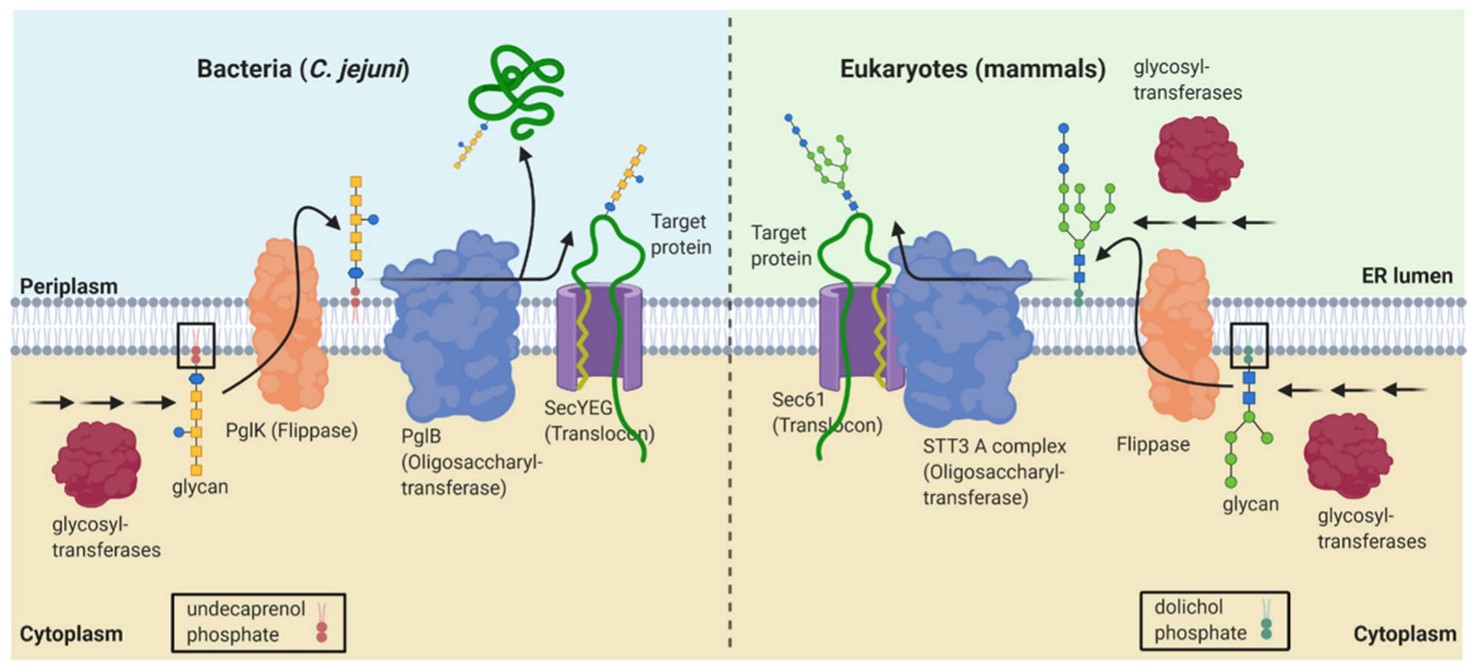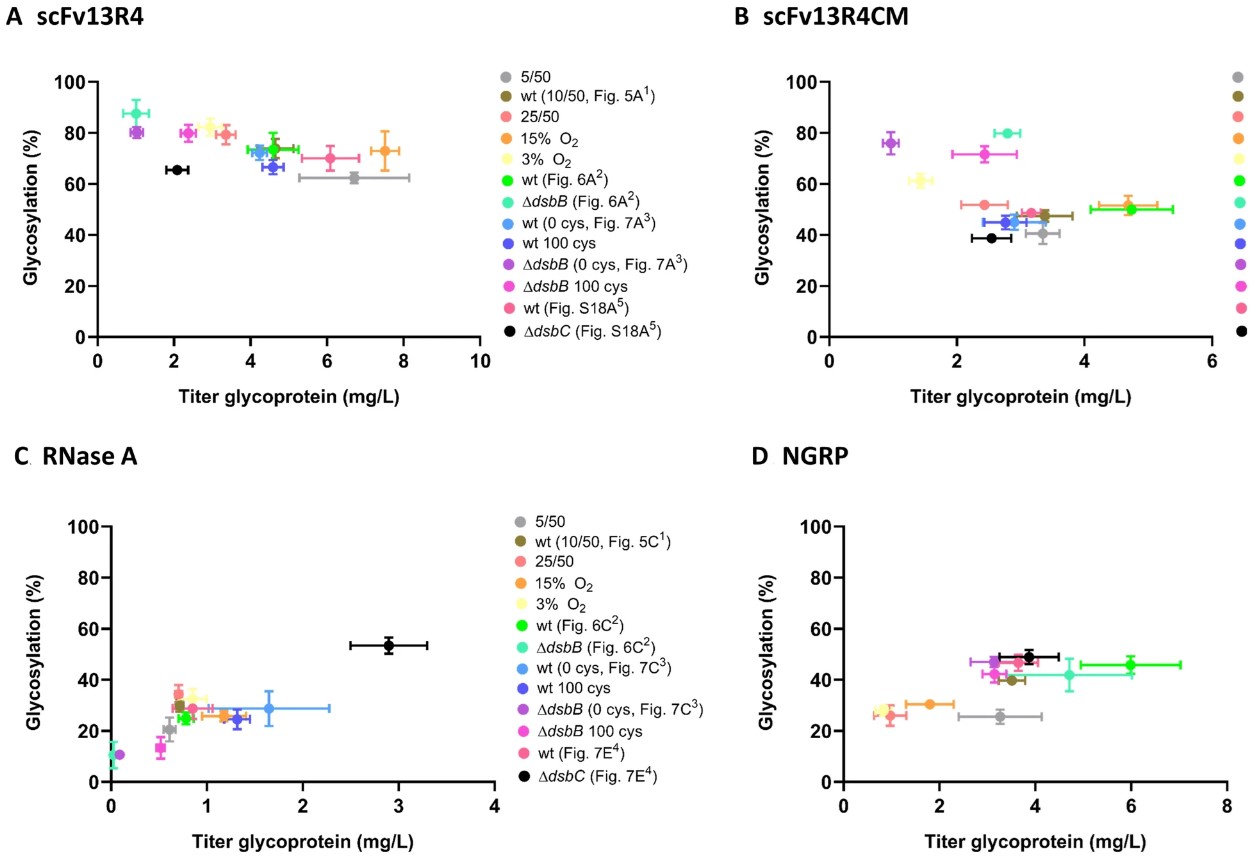N-Linked Glycoengineering Service in Bacteria
Native N-Glycosylation in Bacteria and Eukaryotes
The most extensively studied N-glycosylation pathway, pgl, is found in the bacterium C. jejuni, which shares a similar process observed in eukaryotes. In both cases, it involves the assembly of a glycan on a lipid carrier Und-PP, which is referred to as a lipid-linked oligosaccharide (LLO). Subsequently, these synthesized Und-PP-linked glycans are transferred onto the asparagine residue of the acceptor protein by an enzyme called oligosaccharyltransferase (OST). Bacterial N-linked OSTs, such as PglB from C. jejuni, exhibit sequence homology with the eukaryotic STT3 enzyme, which is capable of facilitating both co- and post-translocational glycosylation. Notably, the PglB enzyme has been shown to have remarkable flexibility in terms of glycan substrate specificity. This glycosylation pathway was successfully transferred and functionally expressed in E. coli, and demonstrated that bacteria could serve as an alternative source for producing recombinant human N-linked glycoproteins.
 Fig.1 Native N-glycosylation pathways in bacteria and eukarytes.1
Fig.1 Native N-glycosylation pathways in bacteria and eukarytes.1
N-Linked Glycoengineering Services in Bacteria at Creative Biolabs
Previous studies have laid the foundation for the development of bacteria-based production of human glycoproteins. From genetically engineered bacteria, the protein of interest can be modified with a specific glycan moiety at a designated position. Armed with leading-edge technologies for genetic glycoengineering, Creative Biolabs provides professional services to engineer heterologous N-glycosylation pathways into bacteria, aiming to produce recombinant glycoproteins with customized N-glycans. We have developed a bottom-up synthetic system for humanizing the N-glycosylation pathway in bacteria. This involves the introduction of genes related to the biosynthesis of N-glycosylation through Knockin or Overexpression, and the key steps include:
-
Transferring C. jejuni PglB into other bacterial species such as E. coli.
-
Engineering bacterial sequons into eukaryotic proteins for PglB recognition.
-
Introducing ALG genes for LLO acceptor assembly.
-
Utilizing E. coli native WecA protein for primary glycan synthesis.
-
Overexpressing glycosyltransferases and sialyltransferase to obtain sialylated N-glycoproteins.
Building upon these glycoengineering modifications, we provide a range of services in N-linked glycoengineering. Furthermore, we have successfully established a Glycoengineered E. coli for Human Protein Production. Our services encompass a wide array of strategies and techniques, including those mentioned above but not limited to them.
Advantages of Our Services
-
Multiple strategies for N-linked bacterial glycoengineering
-
Highly efficient introduction and high-level expression of target genes
-
High-quality glycoprotein products with designer glycans
-
Professional team with extensive experience in glycoengineering
Published data
The production of N-linked glycoproteins in adaptable bacterial hosts can simplify bioprocesses and reduce production costs. However, the improvement of glycosylation efficiency is affected by the target protein sequence, so the production host needs to be optimized. In this paper, Escherichia coli was used as a host to explore a series of N-linked glycosylation strategies to enhance recombinant N-linked glycosylation mediated by Campylobacter-derived PglB oligosaccharyltransferase in E. coli. The various strategies introduced here helped improve the glycosylation process in heterologous hosts and provided new ideas and strategies for enhancing N-linked glycosylation in E. coli to produce multiple glycoproteins.
 Fig.2 Glycosylation efficiency and glycoprotein titer analysis results during E. coli production.1
Fig.2 Glycosylation efficiency and glycoprotein titer analysis results during E. coli production.1
Creative Biolabs takes great pride in our expertise in providing N-linked glycoengineering services in bacteria based on various strategies and genetic techniques. If you require more detailed information or have specific inquiries about our glycoengineering services, please don't hesitate to contact us for more information.
Reference
-
Pratama, Fenryco, Dennis Linton, and Neil Dixon. "Genetic and process engineering strategies for enhanced recombinant N-glycoprotein production in bacteria." Microbial Cell Factories 20 (2021): 1-25. Distributed under Open Access license CC BY 4.0, without modification.
For Research Use Only.
Related Services

 Fig.1 Native N-glycosylation pathways in bacteria and eukarytes.1
Fig.1 Native N-glycosylation pathways in bacteria and eukarytes.1
 Fig.2 Glycosylation efficiency and glycoprotein titer analysis results during E. coli production.1
Fig.2 Glycosylation efficiency and glycoprotein titer analysis results during E. coli production.1



